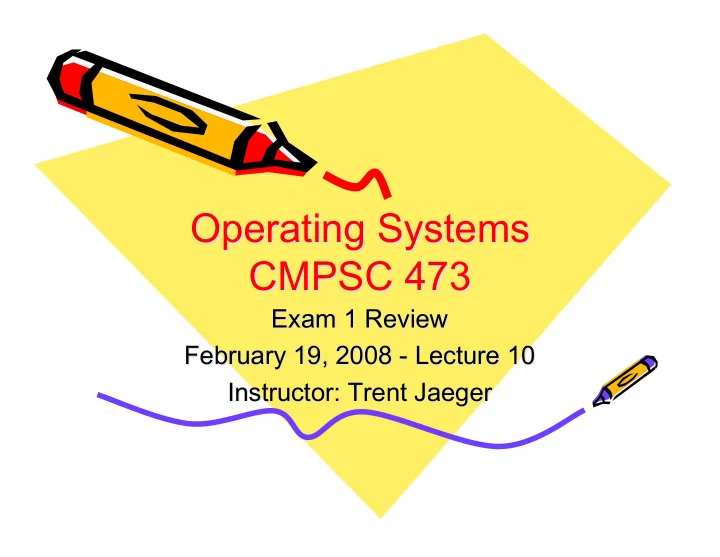

Operating Systems Operating Systems CMPSC 473 CMPSC 473 Exam 1 Review Exam 1 Review February 19, 2008 - Lecture 10 10 February 19, 2008 - Lecture Instructor: Trent Jaeger Instructor: Trent Jaeger
• Exam Structure – (12) Short Answer (1-3 sentences) • 3-4 pts each – (4) Long Answer (2 paragraphs max) • 7 pts each – (3) Constructions (several related, small questions) • 10-12 pts each
• Exam Structure – (12) Short Answer (1-3 sentences) • How and what questions – How does X work? – What is Y? – (4) Long Answer (2 paragraphs max) • How and why questions – How and why does X work that way? – The ‘why’ may be implicit, but do not assume that I know that you know how these work – (3) Constructions (several related, small questions) • Specific questions about OS mechanisms/concepts
• Scope – About 1/3 to 1/2 is related to HWs – Test covers all topics that we discussed in class • But, not all the answers are specified in the slides – And related sections in book • We followed pretty closely in Chs. 3-5 – Hopefully, your notes are good (or you have a good memory of what we discussed)
• Scope – Chapter 1-5 – More emphasis on chapters 3-5 (others were review)
• Chapter 1 – Hardware concepts • CPU – Internals • Memory – Memory hierarchy • I/O devices – Interaction – Communication mechanisms • Interrupts • Bus
• Chapter 2 – OS structure – What is the OS? • Functions – OS API • System call processing • Process and file system calls • (we’ll come back to mmap later) – Process structure (address space) – OS structures • Monolithic and microkernel
• Chapter 3 – Process Structure (Address space) • Process creation (fork/exec) • Process loading (executables and libraries) – Process representation in kernel (structure) • Context switch • Hierarchy – Process states – Interprocess communication • Shared memory • Message passing • In detail -- studying actual systems will help understand the concepts – Remote procedure calls
• Chapter 4 -- Threads – Purpose of threads – Threading models – Thread context switch – Thread system issues – Threading system basics • Clone system call • Linux threads • Pthreads invocation, termination
• Chapter 5 -- Scheduling – Concepts • Bursts, preemption, basic criteria – I/O bound and CPU bound processes – Algorithms • FCFS, SJF, RR, priority • Exponential average • Multiqueue scheduling (combinations of above) – Study Linux/Solaris to better understand scheduling
• Overall – Probably a bit long -- don’t dawdle over 3 pts – Fairly broad set of topics – Clear understanding of a lot of stuff is required • Fewer computations than later tests…
Recommend
More recommend